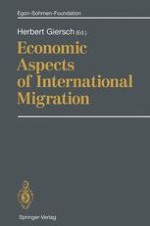1994 | OriginalPaper | Buchkapitel
The National Labor Market Consequences of U.S. Immigration
verfasst von : Michael J. Greenwood, John M. McDowell
Erschienen in: Economic Aspects of International Migration
Verlag: Springer Berlin Heidelberg
Enthalten in: Professional Book Archive
Aktivieren Sie unsere intelligente Suche, um passende Fachinhalte oder Patente zu finden.
Wählen Sie Textabschnitte aus um mit Künstlicher Intelligenz passenden Patente zu finden. powered by
Markieren Sie Textabschnitte, um KI-gestützt weitere passende Inhalte zu finden. powered by
Since the imposition of restrictive entry quotas in the early 1920s, U.S. immigration issues have generally been of little concern to economists. First binding quotas, and later the effects of the depression and World War II, resulted in sharply reduced immigration compared with levels of the late nineteenth and early twentieth centuries. When, during the 1950s, immigration again began to rise toward quota ceilings, population was growing rapidly from other sources, and thus immigration continued to contribute relatively little to U.S. population growth. Moreover, during this period mortality among the aging stock of foreign-born more than offset net immigration, with the consequence that the stock declined by 4.6 million between 1930 and 1970. What attention was directed at international migration issues during this half century was mainly on the part of economic historians, who focused on the period of unrestricted flows, and on the part of those interested in the brain drain, who were concerned with the flow of high-level manpower from poor to rich countries.
